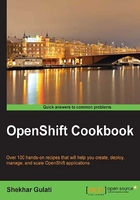
Conventions
In this book, you will find a number of styles of text that distinguish between different kinds of information. Here are some examples of these styles, and an explanation of their meaning.
Code words in text, database table names, folder names, filenames, file extensions, pathnames, dummy URLs, user input, and Twitter handles are shown as follows: "Instead of osbook, the message would refer to your domain name."
A block of code is set as follows:
[remote "origin"] url = ssh://52bbf209e0b8cd707000018a@myapp-osbook.rhcloud.com/~/git/blog.git/ fetch = +refs/heads/*:refs/remotes/origin/*
Any command-line input or output is written as follows:
$ ssh 52b823b34382ec52670003f6@blog-osbook.rhcloud.com ls app-deployments app-root git mysql php phpmyadmin
New terms and important words are shown in bold. Words that you see on the screen, in menus or dialog boxes for example, appear in the text like this: "Click on the I Accept button and the browser will redirect to the getting started web page."
Note
Warnings or important notes appear in a box like this.
Tip
Tips and tricks appear like this.